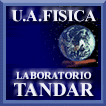We present an
ab initio study of the electronic structure and the structural relaxations
introduced by Cd and Ta impurities when they replace cations in a series of binary oxides.
Calculations were performed with the FLAPW method that allows us to treat the electronic structure
and the atomic relaxations in a fully self-consistent way. We considered different charge states
for each impurity and obtained that electronic properties, in particular the Electric Field
Gradient (EFG), are strongly dependent on these charge states. As
111Cd
and
181Ta are TDPAC probes we can compare the theoretical predictions
with available experimental determinations of the EFG tensor or design key experiments to check
specific theoretical predictions as we did in the case of TiO
2 where we
confirm that Cd is in a charge state and that the EFG tensor changes the orientation of its
principal component with respect to the pure system
[1]. We study
compounds with a variable degree of ionicity: TiO
2,
SnO
2 and In
2O
3 and
obtained that the simple models (like Point Charge with antishielding factors) can not describe the
measured EFG tensor even in systems with a high degree of ionicity.
- [1] L.Errico et al. Phys. Rev. Lett. 89, 055503 (2002).
This research was partially supported by Fundación Antorchas, ANPCyT (PICT 03-03727),
and CONICET, Argentina, and TWAS, Italy.
